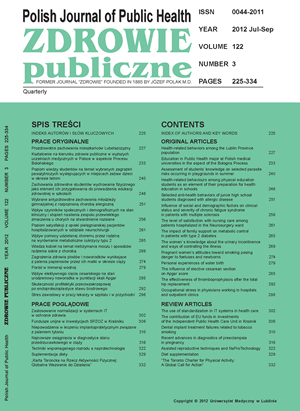The influence of elective cesarean section on Apgar score
Keywords:
elective cesarean section, vaginal birth, Apgar scoreAbstract
Introduction. Over the past years an upward tendency to perform caesarean operations has been noticed all over the world. In our country, the number of these surgical interventions has also exceeded the recommended 15% a long time ago. Complex and multifactorial causes of this situation range from ethical aspects through a more liberal approach towards the implications for caesarean section to an increased number of caesarean sections done at the mother’s request
Aim. This paper is aimed at analyzing the afterbirth condition of newborn babies born by caesarean section and at comparing their condition with that of babies born by vaginal birth. The assumption was to obtain better Apgar scores by babies born by vaginal birth in comparison with babies born by caesarian section.
Material and methods. This paper contains a statistical comparison of Apgar scores measured in the first and the tenth minute of a newborn’s life. The research compares 150 cases of babies born by vaginal birth and selected 150 babies born by caesarean section.
Results. The babies born naturally had better Apgar scores in the first minute of their life in comparison to babies born by caesarean. In the tenth minute of their life a statistical difference between the two groups was not maintained.
Conclusions. The findings show that in cases of unthreatened pregnancies the better solution is to terminate pregnancy by natural birth.
References
1. Odent M. Cesarskie cięcie a poród naturalny. Wrocław: Fundacja Kobieta i Natura; 2010. p.13.
2. Poród nie jest chorobą. 15 zaleceń Światowej Organizacji Zdrowia. www.psychologiadlamam.republika.pl/who.html
3. Chazan B, Troszyński M. Cięcie cesarskie w Polsce. Gin Pol. 2005;76(8):655-60.
4. Troszyński M, Niemiec T, Wilczyńska A. Cięcie cesarskie – dobrodziejstwo czy zagrożenie? Perinatologia, Ginekologia i Neonatologia. 2008;1(1):8-10.
5. Królak-Olejnik B, Halaba Z, Karpe J, et al. Analiza stanu noworodków urodzonych o czasie drogą cięcia cesarskiego w Klinice Perinatologii i Ginekologii w Zabrzu. Perinatologia, Neonatologia i Ginekologia. 2009;2(1):53-6.
6. Suchocki S, Piec P. Cięcie cesarskie na przełomie XX i XXI wieku – aktualne problemy. Gin i Położ. 2007;1(3):15-21.
7. Kolas T, Saugstad OD, Daltveit AK, et al. Planned cesarean versus planned vaginal delivery at term: Comparison of newborn infant outcomes. Am J Obst Gin. 2006;195:1538-43.
8. Fogelson NS, Menard MK, Husley T, Ebeling M. Neonatal impact of elective repeat cesarean delivery AT term: A comment on patient choice cesarean delivery. Am J Obst Gin. 2005;192:1433-6.
9. Piec P, Suchocki S, Obst M, et al. Ocena stanu noworodka urodzonego cięciem cesarskim w porównaniu z porodem drogą pochwową. Perinatologia, Neonatologia i Ginekologia. 2008;1(2):94-6.


